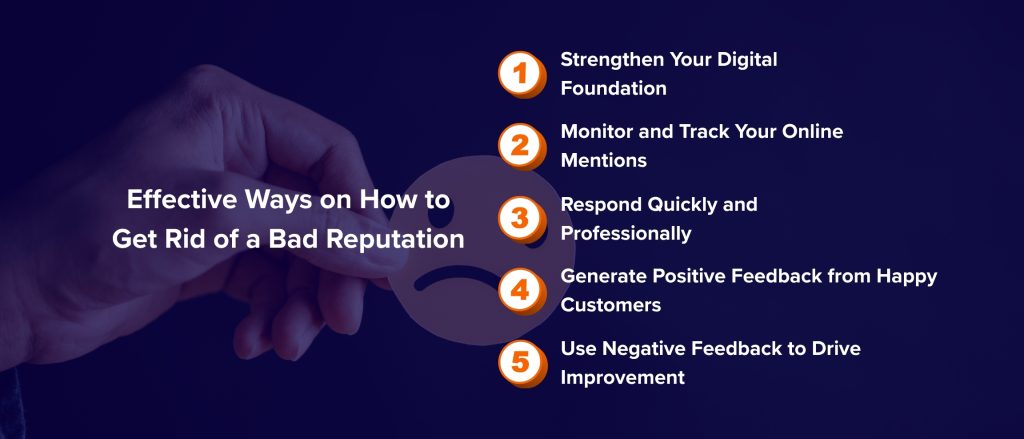
Reputation is one of the most valuable assets any business or individual can have. A single negative review, viral post, or outdated article can quickly overshadow years of hard work, leaving individuals and businesses struggling to regain credibility. Yet, a damaged reputation doesn’t have to be permanent — it can become a powerful opportunity for reinvention.
If you’re searching for effective ways on how to get rid of a bad reputation, the solution lies in strategic action, consistent communication, and genuine accountability. Below, we’ll walk through five proven strategies that can help you rebuild trust, reshape your image, and turn your reputation into one of your strongest brand assets.
Effective Ways on How to Get Rid of a Bad Reputation

Rebuilding a damaged reputation requires a combination of consistency, transparency, and strategic communication. The following proven methods can help you regain trust and reshape public perception over time.
1. Strengthen Your Digital Foundation
Your online presence is often the first impression customers have of your brand. Before addressing negative feedback, ensure that your digital foundation is solid and credible.
Start by optimizing your website and social profiles with accurate, up-to-date information — including your business description, contact details, hours of operation, and visuals that reflect professionalism.
When potential customers search for your brand, they should find trustworthy information from verified profiles, not outdated or incomplete listings. This creates authenticity and helps drown out negative mentions by pushing accurate, consistent, and positive brand signals to the forefront.
2. Monitor and Track Your Online Mentions
You can’t fix what you don’t see. Regularly monitoring online reviews, social media comments, and mentions across platforms gives you control over your digital narrative.
Use online reputation management tools or set up Google Alerts to track when your brand is being discussed. Monitoring helps you identify recurring issues, detect emerging reputation risks early, and respond before negative sentiment spreads.
By staying vigilant, you not only protect your reputation but also gain valuable insights into customer sentiment — empowering you to refine products, services, and communications based on real feedback.
3. Respond Quickly and Professionally
Speed and professionalism go a long way in rebuilding trust. When negative reviews or comments appear, respond promptly and courteously.
Acknowledge the concern, apologize sincerely if warranted, and offer a constructive solution. Avoid defensive language or emotional reactions — these can escalate the situation and further damage credibility.
Publicly addressing issues shows prospective customers that you take feedback seriously and are committed to improvement. Even a brief, empathetic response like “We’re sorry this was your experience. Please reach out directly so we can make things right.” can transform a dissatisfied customer into a loyal advocate.
4. Generate Positive Feedback from Happy Customers
One of the most effective ways to counter negative sentiment is by amplifying positive experiences. Encourage satisfied customers to share their feedback through online reviews, testimonials, or social media shoutouts.
Implement post-purchase follow-up emails or feedback requests to capture positive sentiment when it’s fresh. This helps balance your overall review profile and boosts your credibility in search results.
Remember — authenticity is key. Genuine, unsolicited reviews carry far more weight than scripted testimonials. Encourage honesty, express gratitude, and show appreciation for every customer who takes the time to share their experience.
5. Use Negative Feedback to Drive Improvement
Negative feedback, while difficult to hear, can be one of your greatest assets. Instead of viewing it as a setback, treat it as valuable insight into what your customers truly need.
Identify recurring complaints or concerns and use them to guide internal changes — from customer service training to product development or communication strategies.
When customers see that their voices lead to real improvement, they’re more likely to return and recommend your business to others. Over time, this transparency and adaptability will naturally rebuild your reputation and strengthen brand loyalty.
Bonus Tip — Partner with Reputation Management Experts

Reputation repair can be complex, especially when negative content ranks highly in search results or spreads across multiple platforms. Partnering with a trusted reputation management team can accelerate your recovery and ensure that your brand narrative remains positive and consistent.
Experts can help you analyze online sentiment, optimize digital assets, manage review platforms, and implement long-term strategies to maintain credibility. While reputation takes time to rebuild, professional guidance ensures you’re moving in the right direction with every step.
Ready to see how your business is performing online?
Download your Free Reputation Management Scorecard — a powerful tool designed for business owners and leaders to assess their online review performance. Discover where you stand, identify key improvement areas, and take the first step toward building a stronger, more trusted brand.




